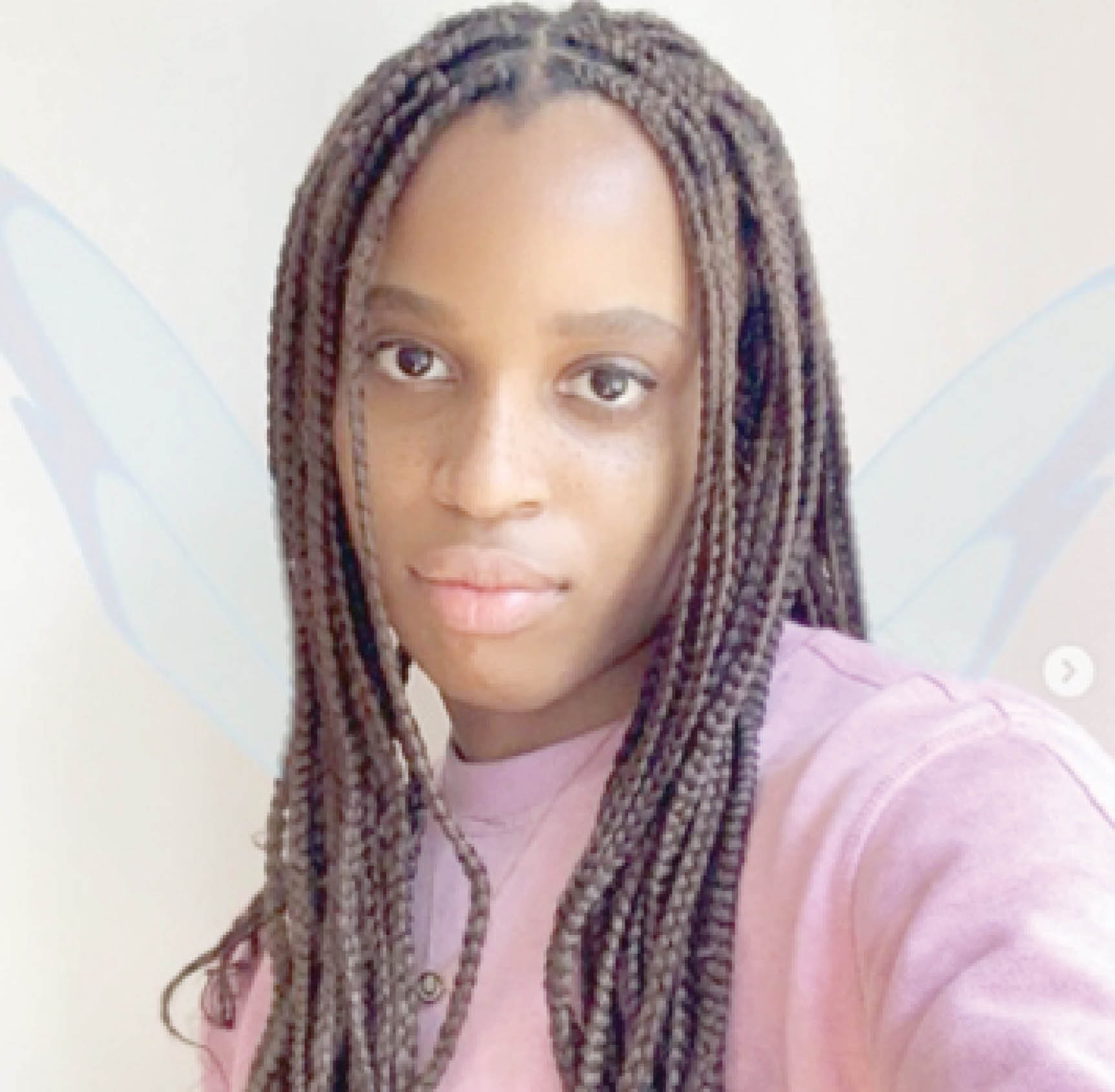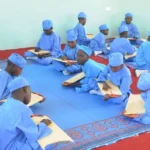Nigerian American artist Chioma Ebinama draws from the language and imagery of mythology to create work that questions and provides escape from embedded Western structures of thought and power. She talks about her work, her process and what inspires her.
You’ve mentioned in interviews that you were reluctant to pursue art as a career, that you didn’t think it would be possible to make a living as an artist. Can you tell us about your journey to becoming a full-time artist?
It was a gradual process. I was more focused on how to make more time for making and not so much on how to make a living. So, it was a bit rocky but I learned every step of the way. The “this is it” moment was probably with my first solo show with Catinca Tabacaru Gallery. I requested that floors be covered with smooth pebbles. I was frustrated with what was available commercially. They drove me to a beach so I could select exactly the size and colour of pebbles I liked. The gallery was turned into a pink cube and we covered the floor, and I was amazed by how a group of people could come together to realise a vision in my mind. I had this same feeling restored with my current solo at Maureen Paley.
How does your background as a sociology graduate inform the work that you do?
I studied Sociology because I was interested in how we are influenced by the external world. More particularly, I wanted to learn how images shape who we are and what we think. With social media and many years of living in New York, which is basically a city of advertisements, I often feel very trapped in a maelstrom of images, images that often extoll values like greed, domination, excess, etc. My sociological eye can’t be closed and sometimes taking it all in feels so violent. And so, I often draw from prehistory or ancient images because, in a way, they have no references to anything familiar to me in the present, so it feels like an escape.
I also like how in the past many artists depicted things they may have never seen in real life. For instance, an early 18th Century European depiction of a leopard feels more interesting because the artist probably had only heard of leopards, and therefore their depiction is both a reflection of pure human imagination and, at once, pointing at the beauty and power of language.

The colours blue and pink feature pretty heavily in your work, can you tell us anything about the significance of those colours for you?
Blue is my favourite colour and in a childish way, it’s hard for me to not use it. Different shades have different significance to me but I use indigo blues heavily in my work because of their connection to all cultures and histories. Blue is a colour that is divine and yet universally accessible. Pink is a fairly new obsession for me, I used to avoid it. I think I was afraid of its strong feminine associations and, for a long time, I sought safety and protection in androgyny, especially in how I presented myself. But, in the last few years, I’ve embraced the pinks. Now, it’s the colour of transformation and rebirth. It also feels like the right colour for where we are now as we collectively learn to purge the toxic belief systems and stories that no longer serve us.
You predominantly make work in ink and watercolour on handmade paper, which is pinned, unframed to the wall. The first thing that struck me when looking at your work was the texture and physicality of it. What is it that draws you to these mediums?
Ink and watercolour require a lot of patience and also acceptance. You can say it’s a zen-like practice, which becomes a meditative process. I love paper because of its immediacy and ephemerality. For me, these mediums are beautiful because of their simplicity. I would love to make epic grand-scale works, but I can’t silence the part of me that thinks it’s rather audacious to make a giant sculpture out of tons of plastic, in light of all the islands of human waste circumventing the globe. I am strangely comforted by the idea that my work is at risk of decay and may require a lot of care to preserve.
The figures in your paintings tend to have their features obscured, sometimes shrouded by what looks like netting. You also created a series of masks constructed of netting and yarn, and one of your series is titled Penumbra, which literally means ‘shroud.’ Can you talk about the significance of this, and how it relates to the Nigerian masquerade tradition?
The tradition of masquerade is prevalent in many different African cultures; however, my masks were inspired by the contemporary masquerades of the Igbo people of Nigeria. Traditionally, a man wears a mask and becomes the embodiment of a spirit. I didn’t grow up experiencing masquerade first-hand, although my dad would often show me the dances. I was more interested in their aesthetic value and how they are typically made collaboratively by the community.
I made the masks during my stay at 16/16, a residency and art space in Lagos (Nigeria). They were an adornment to accompany garments designed by Bubu Ogisi for the IAMISIGO presentation at Lagos Fashion Week in 2018. After they were worn by the models, I released them into the world. I let friends walk around the streets of Lagos in them and watched their reactions. A dancer performed in them. It was interesting to see all the ways the masks could exist. In this way, a mask becomes a portal, an escape.
Your work features themes associated with Afrofuturism, is this a label you connect with?
I feel indebted to the artists and musicians associated with Afrofuturism. But I don’t think this space is the place for me. During the lockdown, I got sort of obsessed with Jeff Bezos and Elon Musk, and their mission to build a better future in space. Looking at them and their prospective empires, I can’t help but think that maybe space is for white people. I wonder if once the earth becomes a barren wasteland, Black people will finally be free to roam the Earth without fear and the burden of being the ‘bad other.’
Are there any artists that you’re either working with or inspired by at the moment?
Last year, I made a limited-edition calendar with my friend Jung Ah Kim, who is based in Korea. We’ve decided to do another one this year. Although I’ve travelled a lot and been fortunate enough to meet and befriend many people, I do spend a lot of time alone. I like my inner world. Every once in a while, I meet someone special that fits into it, and they aren’t always artists.
That said, lately, I have been obsessed with Laurie Anderson. Although a good friend gifted me a copy of Bright Red many years ago, my current obsession started by listening to her reading of The Tibetan Book of the Dead on the project Songs from the Bardo. Since then, I’ve been listening to her regularly and watching her Norton Lecture series at Harvard. She’s given me the courage to record more of my writing, including the sound piece Prayer for when fear strikes dawn currently playing in my solo at Maureen Paley in London.
Your work feels very playful – I’m thinking about the way you use storytelling and mythology, as well as the masks and other objects you’ve made. Also, the way in which you use other materials to transform the exhibition space: the silver trail across the floor in Mammywater and the stones scattered around the space for Penumbras. Is the concept of play important to you, and does it connect with the decolonial, perhaps anti-capitalist themes in your work?
Play is a form of resistance. You know a person isn’t free by how difficult it is for them to enter a state of play.
The titles of your work are also very evocative. How integral is writing and literature to your practice?
All of my work begins with writing. I’ve never been able to keep a proper sketchbook or even make useful sketches for my work. But once I see an image in my mind, I write it down; like writing a poem. From a young age, I wanted to be a writer. As a kid, I often only drew to illustrate my stories. So, the two have always been intimately connected for me.
What can you tell us about your future projects?
The children’s book I illustrated, Emile and the Field, comes out in the Spring in the United States and United Kingdom. I’m very excited to be offering something that is accessible to a broader, and much younger, audience. I’m really trying to expand my audience ages to two and six-year-olds – the real ride or die fans.
Culled from
https://metalmagazine.eu

 Join Daily Trust WhatsApp Community For Quick Access To News and Happenings Around You.
Join Daily Trust WhatsApp Community For Quick Access To News and Happenings Around You.

